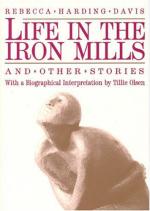|
This section contains 10,285 words (approx. 35 pages at 300 words per page) |

|
SOURCE: “Between Bodies of Knowledge there is a Great Gulf Fixed: A Liberationist Reading of Class and Gender in ‘Life in the Iron Mills’,” in American Quarterly, Vol. 49, No. 1, March, 1997, pp. 113-37.
In the following essay, Hughes maintains that “Life in the Iron Mills” should be read as a religious parable and goes on to analyze the text in the context of liberation.
Critics have recognized Rebecca Harding Davis's “Life in the Iron Mills” as “radical”—calling it “a startling new experiment in literature and a pioneering document in American literature's transition from romanticism to realism.”1 Davis's tale was first published in the April 1861 issue of the Atlantic Monthly, during a period variously identified as Victorian, Romantic, or Sentimental.2 By the time of the Civil War, after transcendentalism's heyday and before the rise of the Social Gospel Movement, the popular moral ethos was something of a stew. If...
|
This section contains 10,285 words (approx. 35 pages at 300 words per page) |

|


